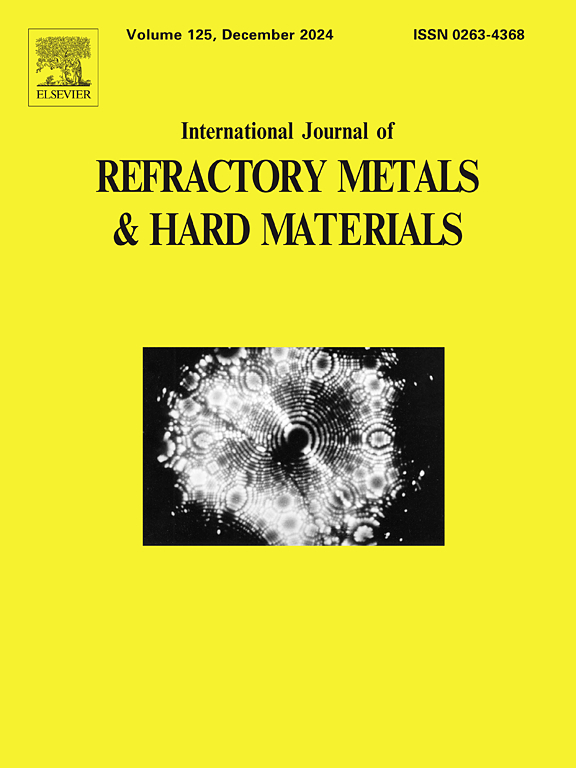(TiCrVZrNb)N高熵氮化陶瓷的固体颗粒侵蚀与磨损行为
IF 4.2
2区 材料科学
Q2 MATERIALS SCIENCE, MULTIDISCIPLINARY
International Journal of Refractory Metals & Hard Materials
Pub Date : 2025-03-25
DOI:10.1016/j.ijrmhm.2025.107165
引用次数: 0
摘要
采用火花等离子烧结法制备了TiN陶瓷、Ti-Cr-V-Zr-Nb-N复合陶瓷和(TiCrVZrNb)N高熵陶瓷。系统地研究了这三种陶瓷的显微组织、硬度和耐磨性之间的关系,重点研究了TiN陶瓷和(TiCrVZrNb)N高熵陶瓷的抗固相颗粒侵蚀性能。结果表明,Ti-Cr-V-Zr-Nb-N复合陶瓷和(TiCrVZrNb)N高熵陶瓷表现为FCC + ZrO2的双相结构,TiN陶瓷表现为单一FCC结构。与TiN陶瓷和Ti-Cr-V-Zr-Nb-N复合陶瓷相比,(TiCrVZrNb)N高熵陶瓷具有更高的硬度和相对密度,并通过原位生成ZrO2颗粒提高了其变形能力。因此,(TiCrVZrNb)N高熵陶瓷具有优异的耐磨性和抗固体颗粒侵蚀性能。揭示了TiN和(TiCrVZrNb)N高熵陶瓷的腐蚀机理。该研究为块状高熵氮化陶瓷在摩擦学和固体颗粒侵蚀领域的研究提供了理论支持。本文章由计算机程序翻译,如有差异,请以英文原文为准。
Solid particle erosion and wear behavior of (TiCrVZrNb)N high-entropy nitride ceramics
The TiN ceramics, Ti-Cr-V-Zr-Nb-N composite ceramics, and (TiCrVZrNb)N high-entropy ceramics were fabricated by spark plasma sintering. The relationship between the microstructure, hardness, and wear resistance of these three ceramics were systematically studied, with emphasis on the solid particle erosion resistance of TiN ceramics and (TiCrVZrNb)N high-entropy ceramics. The results indicated that the Ti-Cr-V-Zr-Nb-N composite ceramics and (TiCrVZrNb)N high-entropy ceramics showed a dual phase structure of FCC + ZrO2, and the TiN ceramics showed a single FCC structure. Compared with TiN ceramics and Ti-Cr-V-Zr-Nb-N composite ceramics, (TiCrVZrNb)N high-entropy ceramics exhibit higher hardness and relative density, and the deformation ability was improved by the in-situ formation of ZrO2 particles. Thus, the (TiCrVZrNb)N high-entropy ceramics exhibit excellent wear resistance and solid particle erosion resistance. The erosion mechanism of TiN and (TiCrVZrNb)N high-entropy ceramics were revealed. This study provides a theoretical support for the research of bulk high-entropy nitride ceramics in the tribology and solid particle erosion fields.
求助全文
通过发布文献求助,成功后即可免费获取论文全文。
去求助
来源期刊
CiteScore
7.00
自引率
13.90%
发文量
236
审稿时长
35 days
期刊介绍:
The International Journal of Refractory Metals and Hard Materials (IJRMHM) publishes original research articles concerned with all aspects of refractory metals and hard materials. Refractory metals are defined as metals with melting points higher than 1800 °C. These are tungsten, molybdenum, chromium, tantalum, niobium, hafnium, and rhenium, as well as many compounds and alloys based thereupon. Hard materials that are included in the scope of this journal are defined as materials with hardness values higher than 1000 kg/mm2, primarily intended for applications as manufacturing tools or wear resistant components in mechanical systems. Thus they encompass carbides, nitrides and borides of metals, and related compounds. A special focus of this journal is put on the family of hardmetals, which is also known as cemented tungsten carbide, and cermets which are based on titanium carbide and carbonitrides with or without a metal binder. Ceramics and superhard materials including diamond and cubic boron nitride may also be accepted provided the subject material is presented as hard materials as defined above.

 求助内容:
求助内容: 应助结果提醒方式:
应助结果提醒方式:


